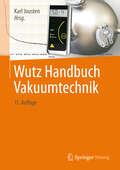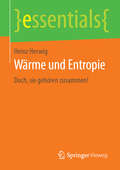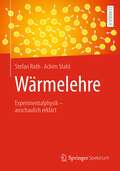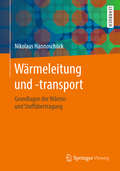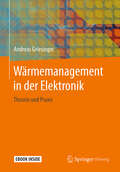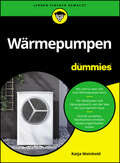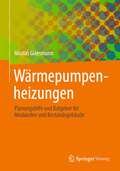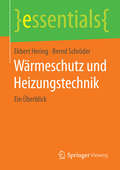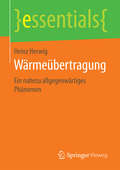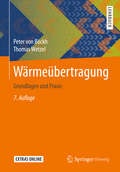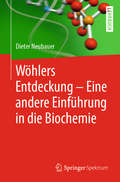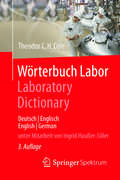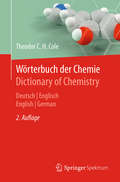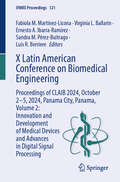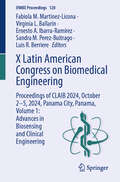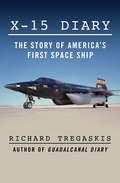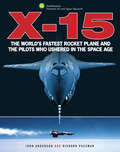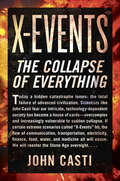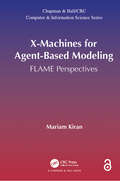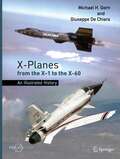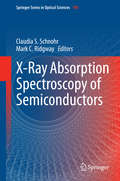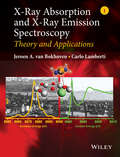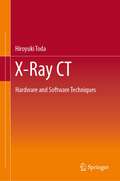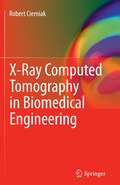- Table View
- List View
Wutz Handbuch Vakuumtechnik: Theorie Und Praxis
by Christian Day Norbert Müller Felix Sharipov Karl Jousten Wolfgang Jitschin Rudolf Lachenmann Alfons Jünemann Uwe Friedrichsen Erik Lippelt Boris Kossek Harald Grave Klaus Galda Robert Ellefson Werner Große Bley Frank Leiter Markus Veldkamp Uwe Meißner Bernhard SchimunekDieses Standardwerk gibt dem Leser umfassend Auskunft über Theorie und Praxis der Vakuumtechnik. Eine große Anzahl von numerischen Beispielen sowie aussagekräftigen Abbildungen erläutert und visualisiert überzeugend die theoretischen Sachverhalte. In der aktuellen Auflage wurde im Kapitel 12 das Pulsrohrverfahren aufgenommen sowie die Abschnitte Kryokondensation und Kryotrapping aktualisiert. Das Kapitel Vakuumsysteme wurde um zwei Abschnitte Berechnung und Druckregelung ergänzt.
Wärme und Entropie: Doch, sie gehören zusammen! (essentials)
by Heinz HerwigHeinz Herwig stellt den fundamentalen Zusammenhang zwischen den beiden Größen Wärme und Entropie heraus und eröffnet damit eine neue Sichtweise. Die Betrachtung der Entropie bei der Energieübertragung in Form von Wärme erlaubt es, Verluste bei der Wärmeübertragung zu benennen und zu bestimmen. Mit dem Konzept des entropischen Potentials einer Energie gelingt es, eine Energieentwertungszahl zu definieren, die einzelne Teilprozesse einer Prozesskette bewerten kann. Für dieses essential werden Kenntnisse über die verschiedenen Arten von Wärmeübertragungen in technischen Systemen vorausgesetzt. Grundlagen hierzu finden sich in dem Band Wärmeübertragung – ein nahezu allgegenwärtiges Phänomen desselben Autors.
Wärmelehre: Experimentalphysik – anschaulich erklärt
by Stefan Roth Achim StahlDas modern gestaltete Lehrbuch zur Experimentalphysik lädt Studierende der Physik und der Nachbardisziplinen dazu ein, die Wärmelehre zu erlernen. Mit anschaulichen Beispielen, einer reichen Bebilderung und modernen Aufgaben führt das Buch durch die Lehrinhalte der Bachelorvorlesung. Die Autoren legen dabei einen Schwerpunkt auf Experimente, die sie anhand vieler Abbildungen erklären, und erleichtern somit das Verständnis der physikalischen Phänomene. Das Buch behandelt die Temperatur und das thermische Gleichgewicht, die Wärme, die Hauptsätze der Thermodynamik, die kinetische Gastheorie, die Entropie, Phasenübergänge und viele technische Anwendungen.
Wärmeleitung und -transport: Grundlagen der Wärme- und Stoffübertragung
by Nikolaus HannoschöckWärme wird in Maschinen und verfahrenstechnischen Anlagen, in der thermischen Energietechnik und in der Bauphysik genutzt oder muss, dort wo sie stört, aus Systemen weggeführt werden. Dieses Lehrbuch handelt vom Wärmetransport und Temperaturfeldern und ihrer Berechnung. Der erste Teil ist eine praxisnahe Einführung und orientiert sich an Aufgabenstellungen, wie sie typisch für den Maschinenbau, die Verfahrenstechnik und die Bauphysik sind. Weitere Kapitel gehen detailliert auf den Wärmeaustausch an Grenzflächen und die Berechnungsverfahren für den stationären und instationären Wärmetransport ein. Der Anhang enthält ein großes Verzeichnis von thermophysikalischen Materialwerten, wie man sie für die Arbeit in der Praxis benötigt.
Wärmemanagement in der Elektronik: Theorie und Praxis
by Andreas GriesingerDas Buch gibt einen Überblick über das Wärmemanagement elektronischer Systeme.Neben den physikalischen Grundlagen der Wärmeübertragung werden passive und aktive Kühlmethoden vorgestellt. Dazu gehören Technologien auf Bauelement- und Substratebene, thermische Interfacematerialien, Kühlkörper, Lüfter und Heatpipes.Für die Analyse von Wärmepfaden werden etablierte und neue Messverfahren beschrieben. Diese liefern thermophysikalische Stoffwerte und thermische Kontaktwiderstände. Zahlreiche Beispiele unterstreichen den Praxisbezug.
Wärmepumpen für Dummies (Für Dummies)
by Katja WeinholdSie möchten verstehen, wie Wärmepumpen funktionieren, wie Sie sie in Ihr (bestehendes) Heiz- und Kühlsystem optimal integrieren, welche Förderung Sie erhalten und welche Kosten im Falle eines Einbaus auf Sie zukämen? Dann ist dieses Buch wie für Sie gemacht. Es erklärt die Technik leicht verständlich, macht mögliche Kosten transparent und unterstützt Sie so bei der Entscheidungsfindung. Darüber hinaus zeigt es Ihnen ganz konkret, welche Schritte Sie unternehmen müssen, wenn Sie sich für einen Einbau entscheiden.
Wärmepumpenheizungen: Planungshilfe und Ratgeber für Neubauten und Bestandsgebäude
by Nicolas GlaesmannDieses Buch erläutert alle relevanten Fragen, die für Hausbesitzer oder private Bauherren zum Thema Wärmepumpenheizungen relevant werden können. Mit Hilfe der Inhalte ist es möglich, die Sinnhaftigkeit des Einbaus einer Wärmepumpenheizung für die eigenen Gegebenheiten zu beurteilen.In den Kapiteln werden die Wirtschaftlichkeit, die Umweltverträglichkeit, die Technik im Allgemeinen, die Planung einer Wärmpumpenheizung sowie Optimierungsmöglichkeiten besprochen. Insbesondere wird dabei auf Wärmepumpen in Bestandsgebäuden eingegangen. Ebenso werden verschiedene Möglichkeiten der Einbindung der Wärmepumpe in die Hauptkomponenten der Heizungsanlage, der Wärmequellen- und Wärmenutzungsanlage dargestellt. Die Einsatzbereiche Kühlung und Warmwasserbereitung mit der Wärmepumpe werden erläutert.Erfahrungen aus der Praxis sowie nachvollziehbare Beispiele ergänzen die sachbezogenen Inhalte. Beispielberechnungen bieten Anhaltspunkte für die Vorgehensweisen und ermöglichen die Prüfung von Fachplanern oder eine eigene grobe Vorplanung.Ziel des Buches ist es, Bauherren bei einer eigenständigen Beurteilung zu unterstützen indem ein objektives Verständnis über die Funktionsweise, Planung und Zweckmäßigkeit von Wärmepumpenheizungen unter den gegebenen Umständen geschaffen wird und ggf. unbegründete Vorbehalte nachvollziehbar zerstreut werden.
Wärmeschutz und Heizungstechnik: Ein Überblick (essentials)
by Bernd Schröder Ekbert HeringBeim Wärmeschutz im Hochbau werden Maßnahmen getroffen, um in beheizten Gebäuden ein für Menschen behagliches Raumklima zu schaffen. Grundlegend ist hierzu die Wärmebewegung durch Bauteile, die es zu berechnen gilt. Mindestanforderungen an den Wärmeschutz im Winter sind nach DIN geregelt. Im Bereich der Heizungstechnik unterscheidet man Einzelheizgeräte für Wohnräume, größere Räume und Hallen. Für die Zentralheizung gibt es je nach Wärmeträger unterschiedliche Systeme. Heizkörper und Heizflächen treten in verschiedenen Ausführungen auf. Neben dem hierfür notwendigen Rohrnetz sind noch Armaturen und meist Umwälzpumpen nötig. Die Wärmeerzeugung erfolgt in Heizkesseln, eventuell unterstützt durch Wärmepumpen und Sonnenkollektoren. Auch Fernheizungen haben sich stellenweise etabliert.
Wärmeübertragung: Ein nahezu allgegenwärtiges Phänomen (essentials)
by Heinz HerwigDieses essential erklärt die Physik der Wärmeübertragung mit den wesentlichen physikalischen Prozessen, der Wärmeleitung und der Wärmestrahlung. Es wird ein grundlegendes Verständnis für die verschiedenen Formen der Energieübertragung in Form von Wärme vermittelt. Die Beispiele dazu stammen weitgehend aus alltäglichen Situationen, wobei unterschiedliche Aspekte kritisch und vertiefend diskutiert werden.
Wärmeübertragung: Grundlagen und Praxis
by Peter Böckh Thomas WetzelDieses Buch vermittelt wie kein anderes die Grundlagen der Wärmeübertragung. Es versetzt den Leser in die Lage, Wärmeübertrager auszulegen sowie Wärmeübertragungsaufgaben aller Art zu analysieren und praktische Lösungen dafür zu finden. Auf ausgedehnte theoretische Herleitungen wird verzichtet, stattdessen werden die wesentlichen Zusammenhänge anhand zahlreicher Beispiele aus dem Ingenieuralltag verdeutlicht.Nach der Einführung in die grundlegenden Begriffe wird der Leser Schritt für Schritt mit den wichtigsten Wärmeübertragungsformen vertraut gemacht. Behandelt werden stationäre und instationäre Wärmeleitung, freie und erzwungene Konvektion, berippte Oberflächen, Kondensation und Verdampfung, Wärmestrahlung sowie die Berechnung von Wärmeübertragern. Ein deutsch-englisches Glossar ergänzt den Stoff. Für die 7. Auflage wurden die Kapitel 3 und 8 überarbeitet und mit neuen Beispielen ergänzt. Anpassungen und Korrekturen aufgrund von Hinweisen der Nutzer des Buches ergänzen die Überarbeitung.Die ZielgruppenEin Buch für Studierende an Universitäten und Fachhochschulen sowie für Ingenieure in der Praxis. Das Buch eignet sich auch als Begleitbuch zum VDI-Wärmeatlas.
Wöhlers Entdeckung - Eine andere Einführung in die Biochemie
by Dieter NeubauerNach Kekules Träume und Demokrit lässt grüßen entführt das neue Buch von Dieter Neubauer den interessierten Leser, Schüler oder Studenten in die faszinierende Wissenschaft der Biochemie. In sieben „Ausflügen“ taucht der Leser in die Welt verschiedener Biomoleküle ein, erfährt mehr über die Energiegewinnung in Zellen, die verschlüsselte Botschaft unserer Erbanlagen und vieles mehr. Auf unterhaltsame Art und Weise werden biochemische Zusammenhänge aus dem Alltag auch für einen Leser ohne besondere Vorkenntnisse leicht verständlich erklärt. Neben umfangreichem Sachwissen und einfach durchzuführenden Versuchen bietet das Buch dem Leser zusätzlich Merkregeln, Eselsbrücken, literarische Abstecher, geschichtliche Rückblicke und eine philosophische Safari – eben eine andere Einführung in die Biochemie.
Wörterbuch Labor / Laboratory Dictionary
by Theodor C.H. Cole Ingrid Haußer-SillerDas Labor ist Ausgangspunkt für medizinische, pharmazeutische, chemische und biowissenschaftliche Forschung. Eine gute Vorraussetzung für effiziente Kommunikation und erfolgreiche Arbeit im Labor ist es, die englischen Fachbezeichnungen zu beherrschen: von Laborausstattung, Geräten, Methoden und Technologie über Chemikalien bis hin zur sicherheitsrelevanten Terminologie. Das Wörterbuch enthält einen Grundwortschatz mit 12.500 Fachbegriffen in beiden Sprachrichtungen. Die 2. Auflage enthält 1000 zusätzliche Begriffe.
Wörterbuch der Chemie / Dictionary of Chemistry: Deutsch/Englisch - English/German
by Theodor C. H. ColeDas kompakte, übersichtliche und vielseitige Wörterbuch der Chemie ist ein unentbehrlicher Begleiter für Wissenschaftler, Übersetzer, Dozenten und Studenten, Lehrer und Schüler zwischen Reagensglas, Bunsenbrenner und "Hightech-Synthesechemie" im Labor. Es behandelt alle Teilgebiete der Chemie von der Allgemeinen und Theoretischen Chemie über die Anorganik zur Organik und Physikalischen Chemie, Biochemie, Nuklearchemie und Polymerchemie wie auch Geräte, Methoden, Analytik und Nanotechnologie. Thematische Begriffsfelder ("clusters") ermöglichen die zusammenhängende Erschließung eines Themas; die Sammlung thematisch verwandter Begriffe unter den jeweiligen übergeordneten Hauptstichwörtern erhöht die "Trefferwahrscheinlichkeit" bei der Wortsuche und erleichtert die Arbeit beim Übersetzen. So erscheinen beispielsweise die diversen spektroskopischen Verfahren unter dem Haupteintrag Spektroskopie - zusätzlich zu den alphabetisch geordneten Einträgen. Dieses innovative Konzept hat sich gegenüber den einfachen Wortlisten anderer Wörterbücher hervorragend bewährt. Theodor C. H. Cole ist amerikanischer Staatsbürger und arbeitet als Dozent, Übersetzer und Autor in Heidelberg. Er studierte Biologie, Chemie und Physik an den Universitäten Heidelberg, Berkeley und Paris und forschte biochemisch-analytisch an Naturstoffen. Mehrere Jahre unterrichtete er an der University of Maryland, European Division, und ist derzeit am Institut für Pharmazie und Molekulare Biotechnologie der Universität Heidelberg tätig. Als Wörterbuchautor ist Theodor Cole bereits bekannt u. a. durch das "Wörterbuch der Tiernamen" (2000) sowie das "Wörterbuch der Biologie" (2. Aufl., 2005).
X Latin American Conference on Biomedical Engineering: Proceedings of CLAIB 2024, October 2-5, 2024, Panama City, Panama, Volume 2: Innovation and Development of Medical Devices and Advances in Digital Signal Processing (IFMBE Proceedings #121)
by Fabiola M. Martinez-Licona Virginia L. Ballarin Ernesto A. Ibarra-Ramírez Sandra M. Pérez-Buitrago Luis R. BerriereThis book reports on the latest research and developments in Biomedical Engineering, with a special emphasis on technologies transforming health in Latin America. This second volume of a 2-volume set covers advances in the development of assistive, therapeutic, and diagnostic devices, and cutting-edge methods for biological signal acquisition and analysis. Throughout the book, a special emphasis is given to low-cost affordable technologies and to their development for and applications in clinical settings. Based on the X Latin American Conference on Biomedical Engineering (CLAIB 2024) held on October 2-5, 2024, in Panama City, Panama, this book provides researchers and professionals in the biomedical engineering field with extensive information on new technologies and current challenges for their clinical applications.
X Latin American Congress on Biomedical Engineering: Proceedings of CLAIB 2024, October 2-5, 2024, Panama City, Panama, Volume 1: Advances in Biosensing and Clinical Engineering (IFMBE Proceedings #120)
by Fabiola M. Martinez-Licona Virginia L. Ballarin Ernesto A. Ibarra-Ramírez Luis R. Berriere Sandra M. Perez-BuitragoThis book reports on the latest research and developments in Biomedical Engineering, with a special emphasis on technologies transforming health in Latin America. This first volume of a 2-volume set covers advances in biosciences, robotics, biosensors and clinical engineering. Throughout the book, a special emphasis is given to low-cost affordable technologies and to their development for and applications in clinical settings. Based on the X Latin American Conference on Biomedical Engineering (CLAIB 2024) held on October 2-5, 2024, in Panama City, Panama, this book provides researchers and professionals in the biomedical engineering field with extensive information on new technologies and current challenges for their clinical applications.
X-15 Diary: The Story of America's First Space Ship
by Richard TregaskisOn August 4, 1960, the X-15 hypersonic manned rocket ship flashed high over Edwards Air Force Base, California, to a new all-time speed record of 2,196 miles an hour. A few days later, the sleek, stub-winged ship soared out of the earth's atmosphere into space to reach the world's record altitude of 136,500 feet. Now, for the first time, Richard Tregaskis, author of Guadalcanal Diary and Invasion Diary, tells the full, engrossing story that lies behind these flights. X-15 Diary marks one of America's greatest chapters in the exploration of space. In order to observe and record the development and flights of this first space ship to be sent to the edges of the infinite realm that we shall be exploring for hundreds of years to come, Richard Tregaskis since February, 1959, has virtually lived with the X-15 project. Here is his engrossing day-by-day story of the dedicated men and women involved in this dramatic enterprise sponsored by the U.S. Air Force and National Aeronautics and Space Administration. Here are the courageous test pilots such as Scott Crossfield of North American Aviation, who has survived explosions in the X-15 and has skillfully brought the rocket craft through other emergencies; Joe Walker of NASA, who attained the all-time world's speed record in the ship; Captain Bob White, U.S.-A.F., who piloted the X-15 to the highest altitude ever reached by man. Here are the brilliant engineers such as Harrison Storms and test conductor Q. C. Harvey of North American Aviation; scientists, technicians, and many others. Here too is the inside story of the baffling problems that have arisen to cause delays and setbacks; the ingenuity and endless hard work through which those obstacles have been overcome; the frightening dangers and uncertainties faced by the test pilots; and the suspense and tension of the record-breaking test flights themselves. Through the pages of the diary there also unfolds the story of earlier work by pioneers in rocketry in many countries-- the pyramid of experimentation of which the rocket ship X-15 is the apex. With its numerous illustrations, its complete and thoroughly up-to-date text, X-15 Diary is both a vivid and significant chronicle of one of America's proudest achievements and a fitting sequel to Mr. Tregaskis's distinguished war diaries.
X-15 Diary: The Story of America's First Space Ship
by Richard TregaskisThe riveting true story of the world&’s fastest plane and the first manned flights into outer space. First tested in 1959, the X-15 rocket plane was at the forefront of the space race. Developed by the US Air Force and the National Aeronautics and Space Administration (NASA) in collaboration with North American Aviation, the X-15 was sleek, black, and powerful—a missile with stubby wings and a cockpit on the nose. By 1961 it could reach speeds over three thousand miles per hour and fly at an altitude of thirty-one miles above the earth&’s surface—the lower reaches of outer space. Acclaimed journalist and bestselling author Richard Tregaskis tells the story of the X-15&’s development through the eyes of the brave pilots and brilliant engineers who made it possible. From technological breakthroughs to disastrous onboard explosions to the bone-crushing effects of intense g-force levels, Tregaskis captures all the drama and excitement of this crucial proving ground for the Mercury, Gemini, and Apollo missions. X-15 Diary recounts a thrilling chapter in the history of the American space program and serves as a fitting tribute to the courageous scientists and adventurers who dared to go where no man had gone before. This ebook features an illustrated biography of Richard Tregaskis including rare images from the American Heritage Center at the University of Wyoming.
X-15: The World's Fastest Rocket Plane and the Pilots Who Ushered in the Space Age (Smithsonian Ser.)
by John Anderson Richard PassmanThe concise illustrated history of the first space plane, featuring exclusive photographs.The exciting story of the X-15—the iconic rocket plane of the Cold War space race is recounted by John Anderson, curator of aerodynamics at the Smithsonian National Air and Space Museum. This experimental space plane was on the cutting edge of hypersonic aerodynamics, and its winged reentry from space foreshadowed the development of the Space Shuttle decades later. Launched from the wing of a modified B-52 bomber—again foretelling a concept that would be used decades later, in this case by SpaceShipOne and SpaceShipTwo—the ship rocketed higher and faster than any manned aircraft of the time. Designed to approach seven times the speed of sound, it was the first hypersonic aircraft ever created and was engineered to function both in the Earth’s atmosphere and at the edge of space. Illustrated with period NASA and USAF photographs, as well as exclusive Smithsonian photography of the first of three X-15s built, X-15 captures the risks and dangers of the X-15 program as Anderson follows the test pilots (including Neil Armstrong) who pushed the very limits of their piloting skills to master groundbreaking experimental technology. Even with the fatal crash of the third X-15, the overall success of the program helped pave the way for NASA to continue to the Moon—and this is the definitive, expertly curated, and beautifully illustrated account of its development.Praise for X-15“[X-15] lays out the case for why the X-15 was and continues to be such an important aircraft. This book makes the reader want to visit the National Air and Space Museum and view the X-15 up-close in a whole new light, in which its aerospace accomplishments rank alongside other distinguished aircraft on display at the museum.” —DefenseMediaNetwork.com“The authors have crafted an excellent introductory story for this aircraft. This book is a good read and I can highly recommend it to anyone who wants to start to learn about this most remarkable airplane.” —International Plastic Modelers Society
X-Events: The Collapse of Everything
by John L. CastiA necessary and thought-provoking read for the age of coronavirus, exploring eleven scenarios that may trigger the collapse of the modern world — from pandemics to nuclear apocalypse to robot uprisings — and what we can do to prevent and survive them. In the twenty first century, our world has become impossibly complicated, relying on ever more advanced technology that is developing at an exponential rate. Yet it is a fact of mathematical life that higher and higher levels of complexity lead to systems that are increasingly fragile and susceptible to sudden, spectacular collapse.In this highly provocative and grippingly readable book, John Casti brilliantly argues that today’s advanced, overly complex societies have grown highly vulnerable to extreme events that will ultimately topple civilization like a house of cards. Like Nassim Taleb’s The Black Swan meets Jared Diamond’s Collapse, Casti’s book provides a much-needed wake-up call, sounding a fascinating and frightening warning about civilized society’s inability to recover from a global catastrophe.An eye-opening and necessary read, X-Events is a shocking look at a world teetering on the brink of collapse, and a population under constant threat from pandemic viruses, worldwide communication breakdowns, nuclear winter, or any number of unforeseeable “X-Events.” Fascinating and chilling, X-Events provides a provocative tour of the catastrophic outlier scenarios that could quickly send us crashing back to the preindustrial age – and shows that they may not be as far-fetched as they seem.
X-Machines for Agent-Based Modeling: FLAME Perspectives (Chapman & Hall/CRC Computer and Information Science Series)
by Mariam KiranFrom the Foreword: "This book exemplifies one of the most successful approaches to modeling and simulating [the] new generation of complex systems. FLAME was designed to make the building of large scale complex systems models straightforward and the simulation code that it generates is highly efficient and can be run on any modern technology. FLAME was the first such platform that ran efficiently on high performance parallel computers and a version for GPU technology is also available. At its heart, and the reason why it is so efficient and robust, is the use of a powerful computational model ‘Communicating X-machines’ which is general enough to cope with most types of modelling problems. As well as being increasingly important in academic research, FLAME is now being applied in industry in many different application areas. This book describes the basics of FLAME and is illustrated with numerous examples."—Professor Mike Holcombe, University of Sheffield, UK Agent-based models have shown applications in various fields such as biology, economics, and social science. Over the years, multiple agent-based modeling frameworks have been produced, allowing experts with non-computing background to easily write and simulate their models. However, most of these models are limited by the capability of the framework, the time it takes for a simulation to finish, or how to handle the massive amounts of data produced. FLAME (Flexible Large-scale Agent-based Modeling Environment) was produced and developed through the years to address these issues. This book contains a comprehensive summary of the field, covers the basics of FLAME, and shows how concepts of X-machines, can be stretched across multiple fields to produce agent models. It has been written with several audiences in mind. First, it is organized as a collection of models, with detailed descriptions of how models can be designed, especially for beginners. A number of theoretical aspects of software engineering and how they relate to agent-based models are discussed for students interested in software engineering and parallel computing. Finally, it is intended as a guide to developers from biology, economics, and social science, who want to explore how to write agent-based models for their research area. By working through the model examples provided, anyone should be able to design and build agent-based models and deploy them. With FLAME, they can easily increase the agent number and run models on parallel computers, in order to save on simulation complexity and waiting time for results. Because the field is so large and active, the book does not aim to cover all aspects of agent-based modeling and its research challenges. The models are presented to show researchers how they can build complex agent functions for their models. The book demonstrates the advantage of using agent-based models in simulation experiments, providing a case to move away from differential equations and build more reliable, close to real, models. The Open Access version of this book, available at https://doi.org/10.1201/9781315370729, has been made available under a Creative Commons Attribution-Non Commercial-No Derivatives 4.0 license.
X-Planes from the X-1 to the X-60: An Illustrated History (Springer Praxis Books)
by Michael H. Gorn Giuseppe De ChiaraForeword by Dr. Roger D. Launius, Former NASA Chief Historian For the past 75 years, the U.S. government has invested significant time and money into advanced aerospace research, as evidenced by its many experimental X-plane aircraft and rockets. NASA's X-Planes asks a simple question: What have we gained from it all? To answer this question, the authors provide a comprehensive overview of the X-plane’s long history, from the 1946 X-1 to the modern X-60. The chapters describe not just the technological evolution of these models, but also the wider story of politics, federal budgets, and inter-agency rivalries surrounding them. The book is organized into two sections, with the first covering the operational X-planes that symbolized the Cold War struggle between the U.S. and the U.S.S.R, and the second section surveying post-Cold War aircraft and spacecraft. Featuring dozens of original illustrations of X-plane cross-sections, in-flight profiles, close-ups, and more, this book will educate general readers and specialists alike.
X-Ray Absorption Spectroscopy of Semiconductors
by Claudia S. Schnohr Mark C. RidgwayX-ray Absorption Spectroscopy (XAS) is a powerful technique with which to probe the properties of matter, equally applicable to the solid, liquid and gas phases. Semiconductors are arguably our most technologically-relevant group of materials given they form the basis of the electronic and photonic devices that now so widely permeate almost every aspect of our society. The most effective utilisation of these materials today and tomorrow necessitates a detailed knowledge of their structural and vibrational properties. Through a series of comprehensive reviews, this book demonstrates the versatility of XAS for semiconductor materials analysis and presents important research activities in this ever growing field. A short introduction of the technique, aimed primarily at XAS newcomers, is followed by twenty independent chapters dedicated to distinct groups of materials. Topics span dopants in crystalline semiconductors and disorder in amorphous semiconductors to alloys and nanometric material as well as in-situ measurements of the effects of temperature and pressure. Summarizing research in their respective fields, the authors highlight important experimental findings and demonstrate the capabilities and applications of the XAS technique. This book provides a comprehensive review and valuable reference guide for both XAS newcomers and experts involved in semiconductor materials research.
X-Ray Absorption and X-Ray Emission Spectroscopy
by Jeroen A. van Bokhoven Carlo LambertiDuring the last two decades, remarkable and often spectacular progress has been made in the methodological and instrumental aspects of x-ray absorption and emission spectroscopy. This progress includes considerable technological improvements in the design and production of detectors especially with the development and expansion of large-scale synchrotron reactors All this has resulted in improved analytical performance and new applications, as well as in the perspective of a dramatic enhancement in the potential of x-ray based analysis techniques for the near future. This comprehensive two-volume treatise features articles that explain the phenomena and describe examples of X-ray absorption and emission applications in several fields, including chemistry, biochemistry, catalysis, amorphous and liquid systems, synchrotron radiation, and surface phenomena. Contributors explain the underlying theory, how to set up X-ray absorption experiments, and how to analyze the details of the resulting spectra. X-Ray Absorption and X-ray Emission Spectroscopy: Theory and Applications: Combines the theory, instrumentation and applications of x-ray absorption and emission spectroscopies which offer unique diagnostics to study almost any object in the Universe. Is the go-to reference book in the subject for all researchers across multi-disciplines since intense beams from modern sources have revolutionized x-ray science in recent years Is relevant to students, postdocurates and researchers working on x-rays and related synchrotron sources and applications in materials, physics, medicine, environment/geology, and biomedical materials
X-Ray CT: Hardware and Software Techniques
by Hiroyuki TodaThis book provides easy-to-understand explanations to systematically and comprehensively describe the X-ray CT technologies, techniques, and skills used for industrial and scientific purposes. Included are many references along with photographs, figures, and equations prepared by the author. These features all facilitate the reader's gaining a deeper understanding of the topics being discussed. The book presents expertise not only on fundamentals but also about hardware, software, and analytical methods for the benefit of technical users. The book targets engineers, researchers, and students who are involved in research, development, design, and quality assurance in industry and academia.
X-Ray Computed Tomography in Biomedical Engineering
by Robert CierniakComputed Tomography gives a detailed overview of various aspects of computed tomography. It discusses X-ray CT tomography from a historical point of view, the design and physical operating principles of computed tomography apparatus, the algorithms of image reconstruction and the quality assessment criteria of tomography scanners. Algorithms of image reconstruction from projections, a crucial problem in medical imaging, are considered in depth. The author gives descriptions of the reconstruction methods related to tomography scanners with a parallel X-ray beam, trough solutions with fan-shaped beam and successive modifications of spiral scanners. Computed Tomography contains a dedicated chapter for those readers who are interested in computer simulations based on studies of reconstruction algorithms. The information included in this chapter will enable readers to create a simulation environment in which virtual tomography projections can be obtained in all basic projection systems. This monograph is a valuable study on computed tomography that will be of interest to advanced students and researchers in the fields of biomedical engineering, medical electronics, computer science and medicine.
